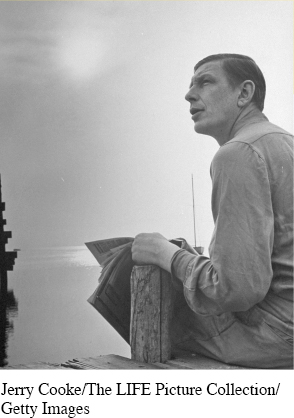Musée des Beaux Arts
W. H. Auden

Wystan Hugh (W. H.) Auden (1907–
About suffering they were never wrong,
The Old Masters: how well they understood
Its human position; how it takes place
While someone else is eating or opening a window or just walking dully along;
5 How, when the aged are reverently, passionately waiting
For the miraculous birth, there always must be
Children who did not specially want it to happen, skating
On a pond at the edge of the wood:
They never forgot
10 That even the dreadful martyrdom must run its course
Anyhow in a corner, some untidy spot
Where the dogs go on with their doggy life and the torturer’s horse
Scratches its innocent behind on a tree.
In Brueghel’s Icarus, for instance: how everything turns away
15 Quite leisurely from the disaster; the ploughman may
Have heard the splash, the forsaken cry,
But for him it was not an important failure; the sun shone
As it had to on the white legs disappearing into the green
Water; and the expensive delicate ship that must have seen
20 Something amazing, a boy falling out of the sky,
Had somewhere to get to and sailed calmly on.
seeing connections
Auden’s poem refers to this painting, Landscape with the Fall of Icarus, by Pieter Bruegel “The Elder” (1525–
The title of this painting, Landscape with the Fall of Icarus, suggests that the focus of the painting is more on the landscape than on the myth. The fallen Icarus is reduced to a small pair of bare legs splashing down in the bottom right corner.
What point is Bruegel making through this artistic choice? What perspective on this painting does Auden’s poem add?

Understanding and Interpreting
This poem is a direct response to Bruegel’s Landscape with the Fall of Icarus (above). After taking a moment to review the painting that inspired this poem, discuss whether or not you think Auden’s understanding of the painting is accurate. Explain.
In the second stanza, the characters in the painting are described as turning “away / Quite leisurely from the disaster” (ll. 14–
15), which suggests that everyone in the scene is intentionally ignoring Icarus’s fall. How does the difference between the figures ignoring Icarus’s fall, as opposed just being unaware of it, affect your reading of both the poem and the painting? The Icarus story comes from Greek mythology, and Icarus’s fall is considered to be tragic in the classic sense (refer to the Glossary if you are unsure what constitutes a classic tragedy). In what ways does Auden’s poem bring into question the importance of these and other stories?
Analyzing Language, Style, and Structure
In his poem, Auden begins with an assertion in the first stanza and then provides an example that supports that assertion in the second stanza. Identify the assertion he makes and then discuss whether or not his example supports that assertion.
Auden goes back and forth between using elevated diction such as reverently, miraculous, and martyrdom, and more common language, such as untidy, doggy, and behind. What is the effect of his using both types of diction on the poem as a whole?
Auden juxtaposes general observations regarding the Old Masters’ understanding of suffering with the specific illustration of the myth in Bruegel’s painting. What is the purpose of this juxtaposition in terms of the overall meaning of the poem?
Connecting, Arguing, and Extending
Auden’s poem suggests that sometimes an event that is particularly important to a certain group of people will be entirely insignificant to another group. Think of a time that something important happened to you or someone you knew. Describe the event and then imagine that no one else expressed any interest in that event. How would you respond to people’s lack of interest?
Auden offers his interpretation of Bruegel’s painting in this poem. However, his interpretation was informed by his own knowledge and experience, and not by any “official” interpretation offered by Bruegel. Write a response either supporting or challenging Auden’s interpretation of Bruegel’s painting using details from the painting as well as Auden’s poem.
What challenges do expressing ideas through visual art rather than the written word pose? Are there certain kinds of ideas that are better expressed through visual mediums? Do some ideas lend themselves better to writing? Explain, using the Icarus poems and paintings presented here (pp. 318-323) as part of your evidence.